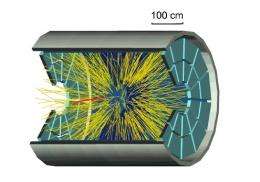This 3D illustration of the STAR Time Projection Chamber shows the track of an antihelium-4 nucleus (red). Image credit: STAR Collaboration, RHIC, Brookhaven National Laboratory.
(PhysOrg.com) -- In 1932, scientists observed the first antimatter particle, a positron (or antielectron). Since then, scientists have observed heavier and heavier states of antimatter: antiprotons and antineutrons in 1955, followed by antideuterons, antitritons, and antihelium-3 during the next two decades. Advances in accelerator and detector technology led to the first production of antihydrogen in 1995 and antihypertriton (strange antimatter) in 2010. Now, scientists with the STAR collaboration at the Relativistic Heavy Ion Collider (RHIC) at Brookhaven National Laboratory have observed another state of antimatter for the first time: the antimatter helium-4 nucleus, which is the heaviest antinucleus observed so far.
As the researchers report in a study posted at arXiv.org, the antihelium-4 nucleus consists of four antiparticles: two antiprotons and two antineutrons. To observe the new antimatter, the scientists collided gold nuclei with each other a billion times. These high-energy collisions produced a quark gluon plasma, which is a hot, dense matter that contains roughly equal numbers of quarks and antiquarks. As the plasma cooled, it transitioned into a hadron gas and produced protons, neutrons, and their antiparticles. The scientists observed a total of 18 antimatter helium-4 nuclei in this gas, demonstrating that antihelium-4 does indeed exist.
As the scientists noted, antihelium-4 will likely be the heaviest antinuclei to be observed for quite a while. The scientists predict that the production of the next heaviest stable antimatter nucleus, antilithium-6, is beyond the reach of current accelerator technology.
The amount of antihelium-4 that the scientists observed in the current experiment can be modeled very closely by thermodynamics, which suggests that there’s not a lot of naturally occurring antihelium-4 in the Universe. In fact, the scientists predict that we’re very unlikely to see any of it in space; if we did observe antihelium-4 in space (or any antinuclei heavier than antihelium-4), it would mean that the antimatter is being produced by another mechanism. And if there were another mechanism for producing antimatter in large enough quantities that we could observe it, that would indicate the existence of a large amount of antimatter somewhere in the Universe.
The Space Shuttle Endeavour, which is currently scheduled to launch in April, is carrying the Alpha Magnetic Spectrometer to the International Space Station to search for particles of antimatter in cosmic rays. The scientists predict that the spectrometer will not detect any antihelium, but if it does, it could have significant implications for antimatter research. One of the biggest questions that cosmologists have is why the observable Universe is made almost entirely of matter and not antimatter. Finding a part of the Universe that contains more antimatter than expected could help scientists find an answer and shed light on what was happening during the early Universe.
More information: STAR Collaboration. "Observation of the antimatter helium-4 nucleus." arXiv:1103.3312v1 [nucl-ex]
via: The Physics ArXiv Blog and Press Release
© 2010 PhysOrg.com






















